Employees of the Center for Military-patriotic education

Shevchenko Yuri Ivanovich
Founder and head of the center
Commander of the student search party «Miusskaya Vysota»
History Teacher

Bychkova Maria Vladimirovna
History Teacher
Employee of the center
Mission and objectives of the Center for Military-Patriotic Education
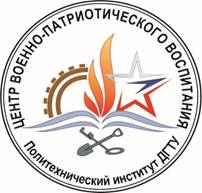
The word «history» in its original meaning goes back to the ancient Greek term (Ιστορία, «research»), which meant «investigation, recognition, establishment.» History has always been identified with the establishment of authenticity, the truth of events and facts, and in Roman historiography (historiography is a branch of historical science that studies its history) this word began to mean not only a way of recognizing, but also a story about the events of the past.
History is a very important field of humanitarian knowledge, a science dealing with the study of a person (his activities, condition, worldview, social ties and organizations, etc.) in the past, knowledge of which is primarily drawn from written sources, artifacts, and the results of archaeological research. Historians use the stories of contemporaries in order to establish the sequence of events, the objectivity of the described facts and draw conclusions about the causes of the events. It is believed that people who do not know history tend to repeat the mistakes of the past (step on the same rake).
In order not to make such mistakes, you need to know your history, the history of your country, the history of the place where you were born, where you live, the history of your family. You need to respect the past of your ancestors, take care of the accumulated knowledge, customs, and skills. Patriotism is nurtured from childhood, and it begins with the love of its history.
The preservation of the historical past, the protection of historical truth is the main mission of the Center for Military-Patriotic Education.
1. To create maximum conditions for students to master the spiritual and cultural values of their ancestors, their way of life, customs;
2. Creating a moral and emotionally favorable environment for the formation of a student’s personality;
3. To form the educational and research skills of students in the process of working on artifacts and historical documents;
4. To develop students’ creative abilities through a differentiated approach, to help them develop informed views on the historical events of our Homeland;
5. To teach to defend the historical truth, to find facts and to be able to use them in discussions and disputes.

The history of the Center for Military-patriotic education of PI (branch) of DSTU in Taganrog
In the early 1990s, the local history club «9 Muses» was established at the Taganrog Polytechnic College at the history room. The club’s program outlined the goals and objectives: bringing learning closer to a problematic understanding of historical material; developing skills in social, independent, research work; fostering love for the native land, patriotism, morality.
The club’s assets include students, teachers, employees of the city’s museums, war veterans, local historians, restorers.
Throughout the work of the club, local history quizzes, Olympiads, staging evenings were constantly organized. In preparation for such evenings, the guys themselves wrote scripts, sewed costumes, and decorated the scenery. Parents, college workshops, and the library were involved in this work. The themes of such evenings were folk festivals, rituals, the era of Peter the Great, the founding of Taganrog, the Great Patriotic War of 1941-1945.
The most important area of the club’s work was search work, hiking and expeditions. They were carefully prepared for them. They conducted reconnaissance, developed memos-textbooks of expeditions, methods of collecting local history material, questionnaires. The participants of the expeditions not only collected local history material, recorded folk songs, visited folk museums, but also made films.
The decisive role in the search work was assigned to military history, namely the events on the Mius-front line. It was a powerful German defensive line along the Mius River. The battles on the Mius Front, in terms of their importance, ferocity and scale of losses, may well be comparable to the largest and most decisive battles of the war. Unfortunately, the battles on the Mius Front remained a half-forgotten page of the Great Patriotic War for many years. And there is still a lot of work to study those military events. We add that in August 1943, the Mius Front was taken by Soviet troops, the city of Taganrog and the entire Rostov region were liberated.
Together with the participants of the liberation of Taganrog, the guys repeatedly drove through the battlefields on the Mius front, made a film, recorded memories. The material collected during the expeditions was put in order, restored, and prepared for exhibitions. Thematically, these were different exhibitions. Such as «Weapons of the Great Patriotic War», «Exhibition of personal collections», «Back in the USSR», «Habits of our antiquity» and many others. Exhibitions were held both on the basis of the college (the current Polytechnic Institute) and at various commemorative events, in parks, on the territories of shopping centers, in villages closest to Taganrog, in factories of the city, in city schools. As a rule, they aroused the interest of the widest segments of the population.
The result of the search work was the opening of the museum in 2003 to mark the 70th anniversary of the liberation of Taganrog from the Nazi invaders. Schoolchildren, students, veterans of war and labor, and guests of Taganrog became guests of the museum. Extensive research work was carried out within the museum, exhibitions were organized to mark the 100th anniversary of the February and October Revolutions. At the museum, groups of guides and restorers, a puppet theater have been established.
After graduating from college, our students often come to military history clubs, reconstruction clubs, and patriotic associations. They do not forget the college museum, they come back with new ideas and projects. One of them was the project «The Warrior of the Kulikovo Battle». During 2010-2011, painstaking work on the project was underway, the young men of the technical department wove chain mail, made an axe, shield and sword. The girls were engaged in sewing shirts, shoes, modeling, decoration, the most difficult work was performed in the college workshop. Painstaking and technically difficult work is the manufacture of chain mail. The project participants chose the most difficult option, when the chain mail was woven from combined rings. The simplest weaving option was 4 in 1, in which the ring was connected to four adjacent ones. The guys tried to be extremely reliable in their work, it took 400 meters of wire to make the chain mail, the weight of the chain mail was 14 kg. This corresponds to historical characteristics. Students received information while working on this project from various sources: the Internet, encyclopedias, paintings by Russian artists.
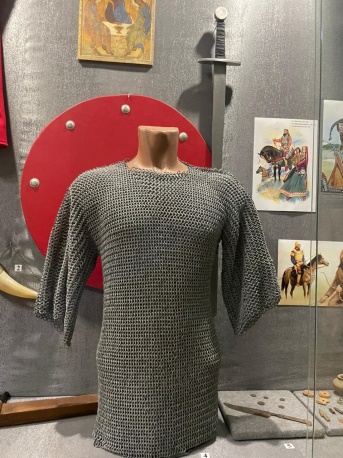
In 2011, a student search team «Miusskaya Vysota» was created on the basis of the museum. The guys annually go to the All-Russian Memorial Vigils in the battle areas on the Mius Front, where work is underway to search for and bury soldiers who died during the Great Patriotic War. It is in the work of the search team that the gap between the theoretical and practical-applied components of military-patriotic education is being overcome. Any search movement is connected with scientific work. It all starts in the archive, where reports are studied, work with maps, drawing on modern maps, linking to the terrain, conducting search reconnaissance, i.e. surveying the area in order to determine the possibility of conducting search operations. When conducting reconnaissance, it is necessary to have a combat map, a compass, a notebook, a sapper shovel, a metal probe, a metal detector, a camera and other tools. And only after that you can go out into the field. Any find, even a small rusty part, is subject to study. Here is an interesting example: on the Mius front line, the expedition participants began to find casings for the German Mauser rifle, which are marked in Arabic! The study began and it turned out that it was an Iranian Mauser. The question arises: where did he get on the Mius front? During the study, it turned out that in the mid-30s, Iran began to create a military-industrial complex. German companies have built a number of factories in Iran, including the Krupp company, which built a shell factory. By 1940, according to the handbook for the Red Army, there were more than 500 thousand Mauser rifles and thousands of machine guns in the Iranian army. After the German invasion of the USSR, in August 1941, the USSR and Great Britain occupied Iran and about half of Iran’s arsenal ended up in the Soviet occupation zone. It was a gift of fate, as it was a difficult time for our country. All these weapons were transferred to the USSR, since they did not meet the standards of the Red Army, it was decided to transfer them to the Transcaucasian military District, which did not conduct combat operations, and it was decided to send our weapons to the active army. The Iranian rifles were handed over to units drafted from the Caucasian republics. Initially, these units were planned to be kept in reserve. But the disaster of 1942 in our sector of the front forced these units into battle. 416 The Azerbaijani Rifle Division was transferred to Taganrog and took an active part in its liberation in August 1943. This is how Iranian rifles and ammunition came to our region.
A lot of work is underway to restore the names of the missing fighters. If this succeeds, relatives are sought, a place of residence is established, work is underway with local military enlistment offices, DNA and examination are carried out, accompanying documents are issued and the remains are transferred to relatives, reburial takes place. The artifacts found during excavations also require a scientific approach. When a rusty metal similar to a weapon is found, the following work is carried out:
1. Find out what kind of weapon it is.
2. To study its scheme, the system of operation, to understand the order of disassembly. Only after that we start cleaning.
3. We begin a long analysis of the disassembly. It is necessary to know the chemistry course in order to properly carry out electrolysis and metal processing.
4. To restore the missing parts according to the drawings.
5. To carry out chemical bluing of metal.
6. To carry out decontamination (so that this exhibit is not considered a weapon, according to the law of the Russian Federation).
7. Collect and process about the recurrence of rust.
Only after that, the exhibit takes pride of place in the museum, indicating the place of discovery, its country of origin and technical characteristics.
The photo shows the result of such work:
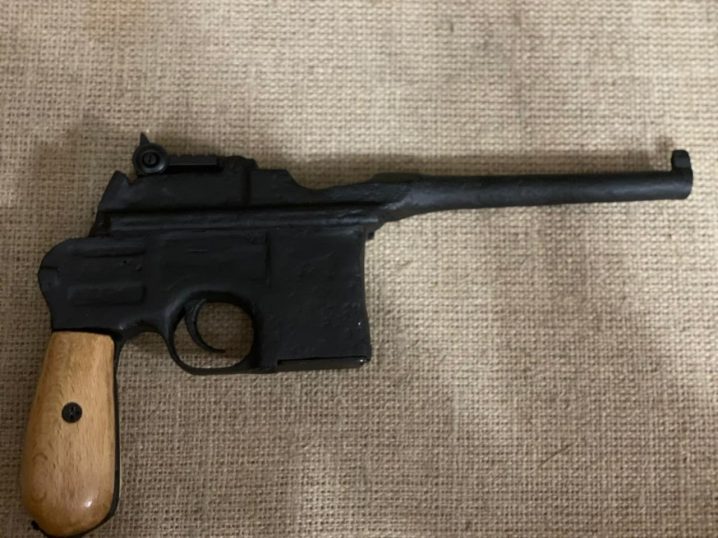
The Mauser pistol
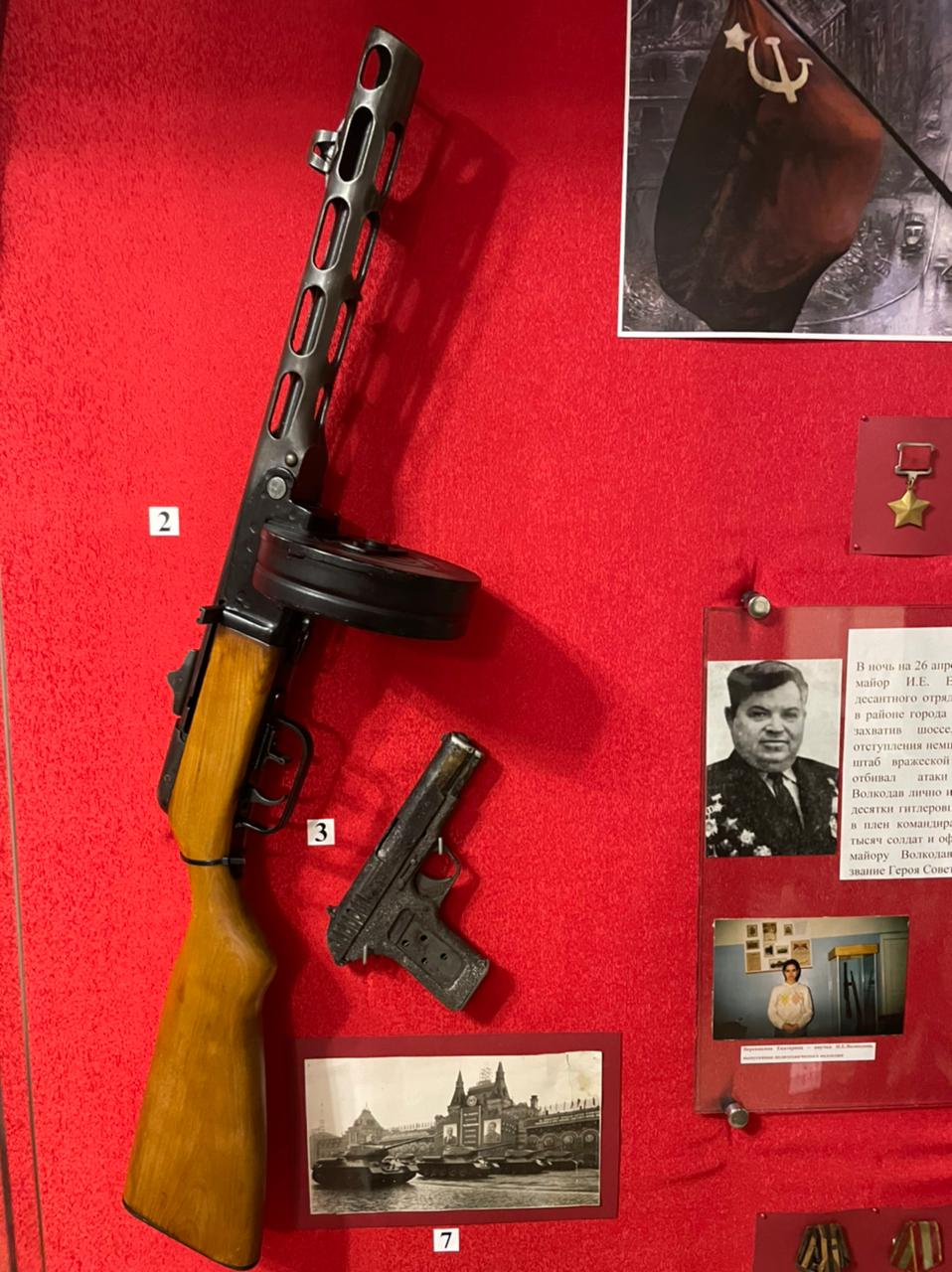
Mosin’s rifle
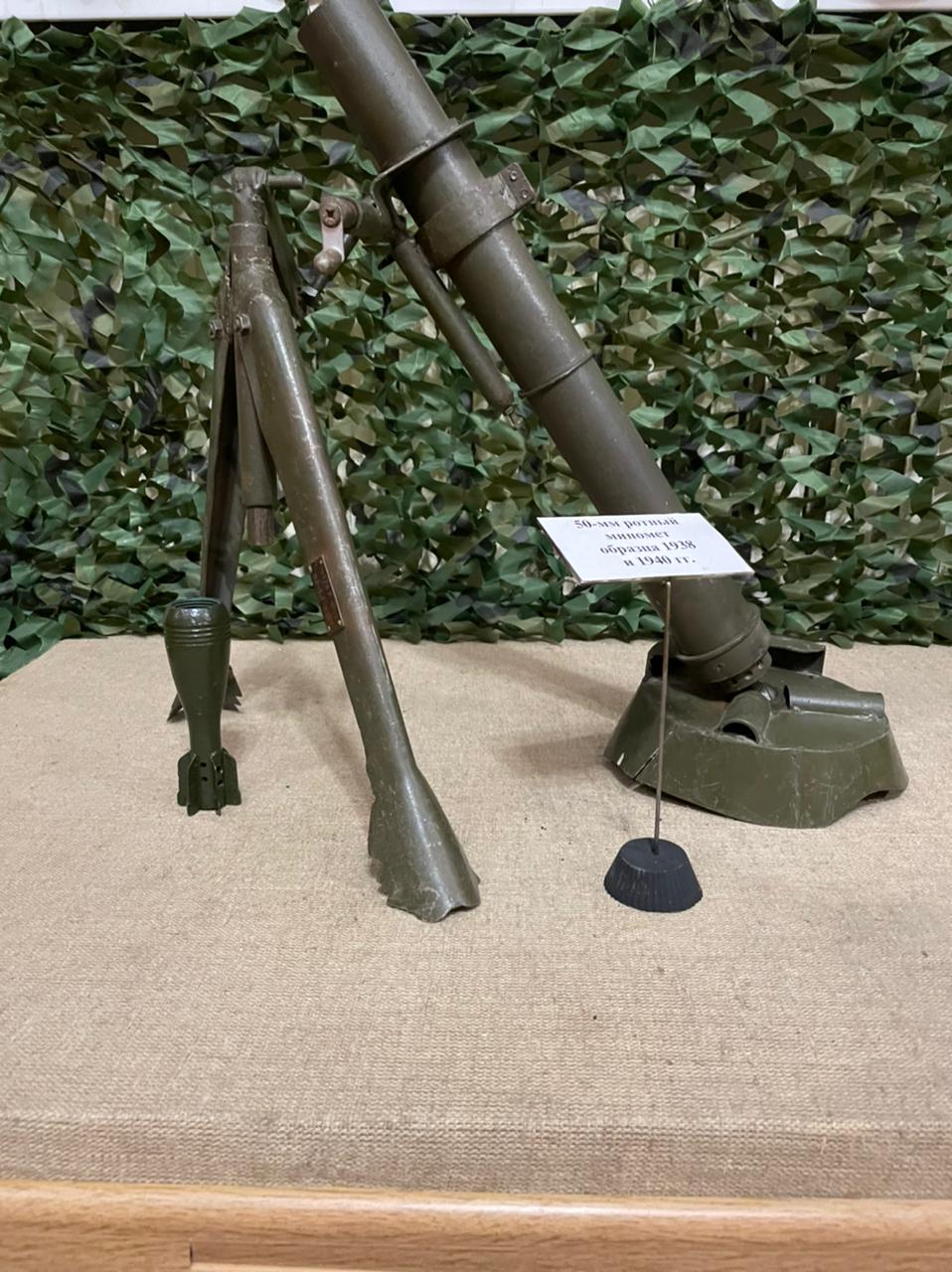
Soviet 50 mm mortar (reconstruction)
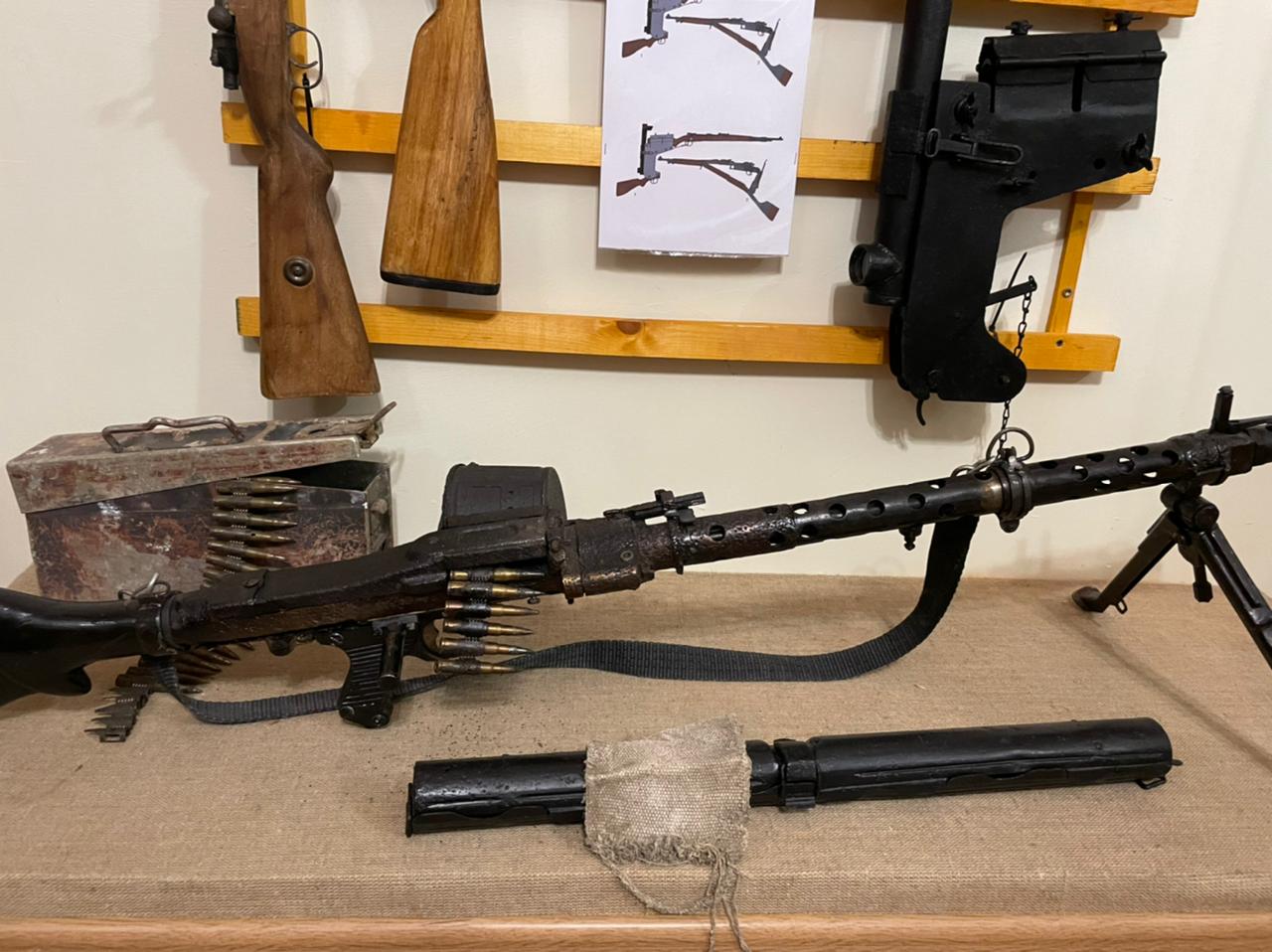
German MG-34 machine gun
In 2017, as part of the Victorious May 1945 forum, the museum organized a bus tour of the memorable places of the Mius Front. A route was developed, guides from among the students were trained, and hundreds of residents of the Rostov region got acquainted with the legendary Mius front, learned a lot of interesting things from the history of our region.
For more than 10 years, hundreds of historical artifacts about the life of people in the Don Region have been collected and prepared for exposition at the institute on the basis of the museum, and the idea arose to create a Military-patriotic Center.
In February 2020, the institute opened a Center for military-patriotic Education, consisting of three halls: 1 hall for classroom classes, meetings, quizzes, Olympiads and two halls of the museum, where you can get acquainted with the history of the Azov region, starting from ancient, Scythian, Greek times and ending with modern history.
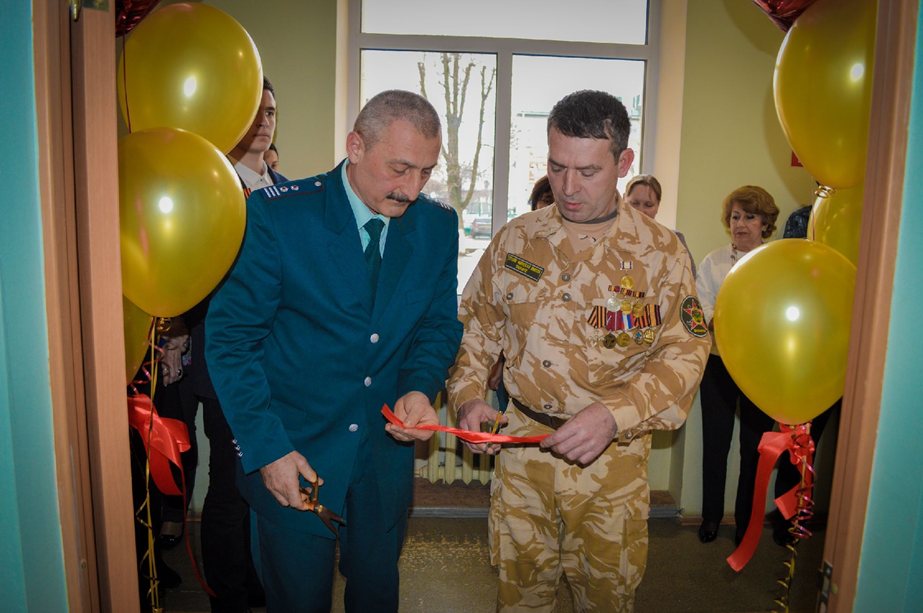 Открытие Центра военно-патриотического воспитания. Ленточки перерезают Данилов Роман Александрович (руководитель городской общественной организации — поисковый отряд «Миусская высота») и Исаев Альберт Катаевич (директор Политехнического института (филиала) ДГТУ в г.Таганроге, 2020 г).
Открытие Центра военно-патриотического воспитания. Ленточки перерезают Данилов Роман Александрович (руководитель городской общественной организации — поисковый отряд «Миусская высота») и Исаев Альберт Катаевич (директор Политехнического института (филиала) ДГТУ в г.Таганроге, 2020 г).
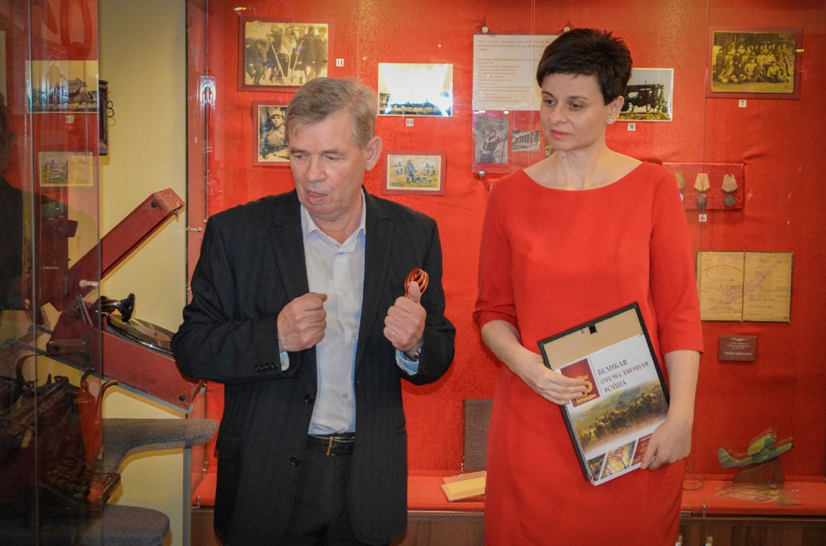 Shevchenko Yuri Ivanovich and Golubeva Irina Valerievna (Deputy head of the city for Social Affairs), 2020.
Shevchenko Yuri Ivanovich and Golubeva Irina Valerievna (Deputy head of the city for Social Affairs), 2020.
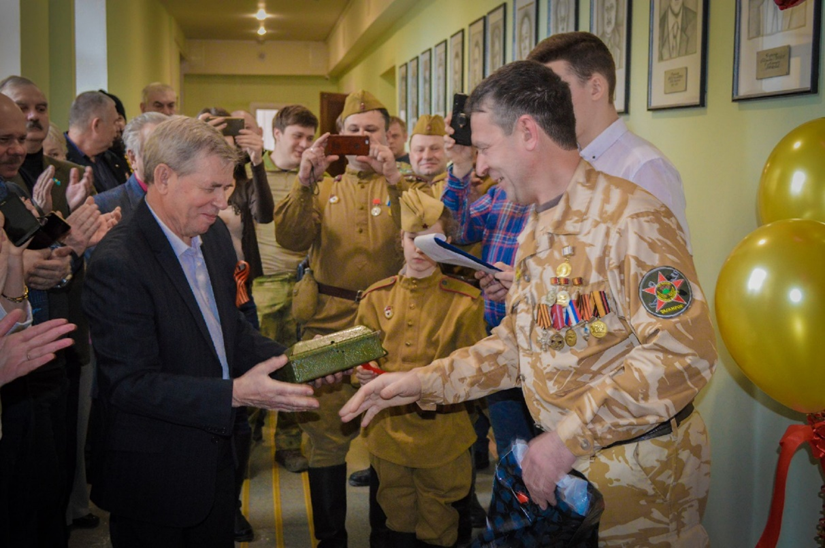 A gift to the exposition fund from the Taganrog search party «Miusskaya Vysota»
A gift to the exposition fund from the Taganrog search party «Miusskaya Vysota»
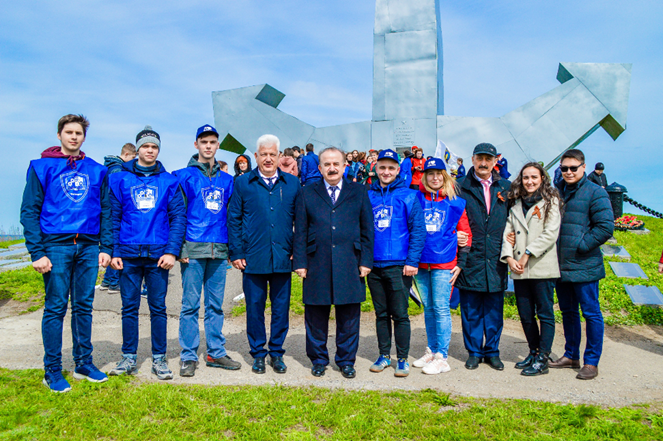 Rector of DSTU Meskhi B.Ch., Head of administration of Matveevo-Kurgan district Rudkovsky A.A. with students and staff of the Polytechnic Institute
Rector of DSTU Meskhi B.Ch., Head of administration of Matveevo-Kurgan district Rudkovsky A.A. with students and staff of the Polytechnic Institute

POLYTECHNIC INSTITUTE (BRANCH)
OF THE FEDERAL STATE BUDGETARY EDUCATIONAL INSTITUTION OF HIGHER EDUCATION
DON STATE TECHNICAL UNIVERSITY
IN TAGANROG, ROSTOV REGION
PI (branch) of DSTU in Taganrog
On the basis of the Polytechnic Institute, history teachers Maria Vladimirovna Bychkova and Yuri Ivanovich Shevchenko hold the following events for students of Taganrog schools:
— Liberation of the city of Taganrog;
— Breakthrough of the Mius Front;
— The history of the military costume;
— The 100th anniversary of the formation of the USSR.
The partisan movement on the Don
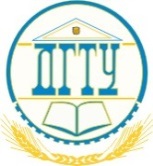
POLYTECHNIC INSTITUTE (BRANCH)
OF THE FEDERAL STATE BUDGETARY EDUCATIONAL INSTITUTION OF HIGHER EDUCATION
DON STATE TECHNICAL UNIVERSITY
IN TAGANROG, ROSTOV REGION
PI (branch) of DSTU in Taganrog
| 1 | Bychkova M.B.
Shevchenko Y.I. |
An exhibition of artifacts dedicated to the 80th anniversary of the liberation of Taganrog | August 2023 |
| 2 | Bychkova M.B.
Shevchenko Y.I. |
Sightseeing tours for the new set of 1 courses | September 2023 |
| 3 | Bychkova M.B.
Shevchenko Y.I. |
Sightseeing tours for schoolchildren of the city | During the year |
| 4 | Bychkova M.B.
Shevchenko Y.I. |
Lessons of Courage (for the 80th anniversary of the liberation of Taganrog) | September-October 2023 |
| 5 | Bychkova M.B.
Shevchenko Y.I. |
Exhibition in Rostov-on-Don at the festival «Turn on Ecology» | September 2023 |
| 6 | Bychkova M.B.
Shevchenko Y.I. |
History quiz «The Wheel of History» for 1st year of secondary education | November 2023 |
| 7 | Bychkova M.B.
Shevchenko Y.I. |
Thematic exhibition «From personal collections» | December 2023 |
| 8 | Bychkova M.B.
|
Lessons of Courage «Lifting the siege of Leningrad» | February 2024 |
| 9 | Shevchenko Y.I. | Lessons of Courage for the anniversary of Operation Bagration | March 2024 |
| 10 | Bychkova M.B.
Shevchenko Y.I. |
The exhibition «The History of military costume» | February-March 2024 |
| 11 | Shevchenko Y.I. | Bus tour of the Mius Front | April 2024 |
| 12 | Bychkova M.B.
|
Bus tour
«The Beam of Death» |
April 2024 |
| 13 | Bychkova M.B.
Shevchenko Y.I. |
The exhibition of Artifacts by May 9. | April-May 2024 |
| 14 | Bychkova M.B.
Shevchenko Y.I. |
One-day trips of the search team along the Mius front | April-May 2024 |